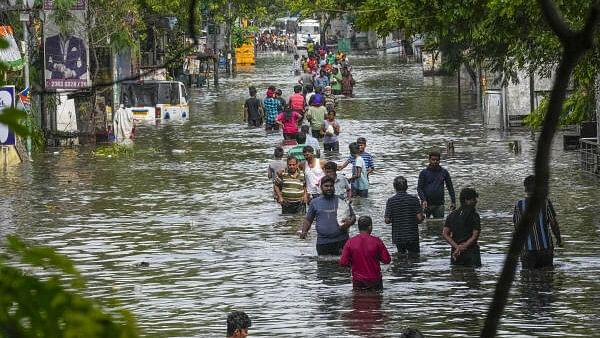
People wade through a waterlogged road after heavy rainfall.
Credit: PTI Photo
Dubai: Worsening climate change made the 2011-2020 decade wetter and warmer for India, according to a new report released by the World Meteorological Organisation (WMO) at the United Nations (UN) climate conference here on Tuesday.
The Decadal State of the Climate 2011-2020 said the rate of climate change surged alarmingly during the period, which was the warmest decade on record.
The decadal report provides a longer-term perspective and compliments the WMO’s annual State of the Global Climate reports.
The provisional annual report for 2023, released at COP28 last week, said 2023 is set to be the warmest year on record.
The WMO, a specialised agency of the UN that covers weather, climate and water resources, said it was a 'wet decade' over northwest India, Pakistan, China and the southern coast of the Arabian Peninsula.
During 2011-2020, the occurrence of extreme warm days was approximately twice the 1961-1990 average in parts of southeast Asia, most of Europe, southern Africa, Mexico and parts of eastern Australia.
“Each decade since the 1990s has been warmer than the previous one and we see no immediate sign of this trend reversing. More countries reported record high temperatures than in any other decade,” said WMO Secretary-General Petteri Taalas.
He said the world's oceans are warming faster and the rate of sea level rise has nearly doubled in less than a generation.
Extreme cold conditions less frequent with warming global temperatures
Extreme cold days and nights in the 2011-2020 period were about 40% below the 1961-1990 average, the UN report said.
India had the worst single flooding episode in a monsoon season in June 2013, when heavy rains, mountain snowmelt and glacial lake outbursts led to extreme flooding and landslides in Uttarakhand, killing more than 5,800 people, the report said.
Kerala was badly affected by floods in 2018 while in 2019 and 2020, India’s two wettest monsoon seasons in the previous 25 years witnessed intense and widespread flooding. Over 2000 flood-related deaths were reported in India and neighbouring countries.
During 2011-2020, drought was declared in 11 of the 28 Indian states, leading to severe food and water insecurity. The report added that the decade was the first since 1950 when there was not a single short-term event with 10,000 deaths or more.
Moreover, heatwaves were responsible for the highest number of casualties, while tropical cyclones caused the most economic damage.